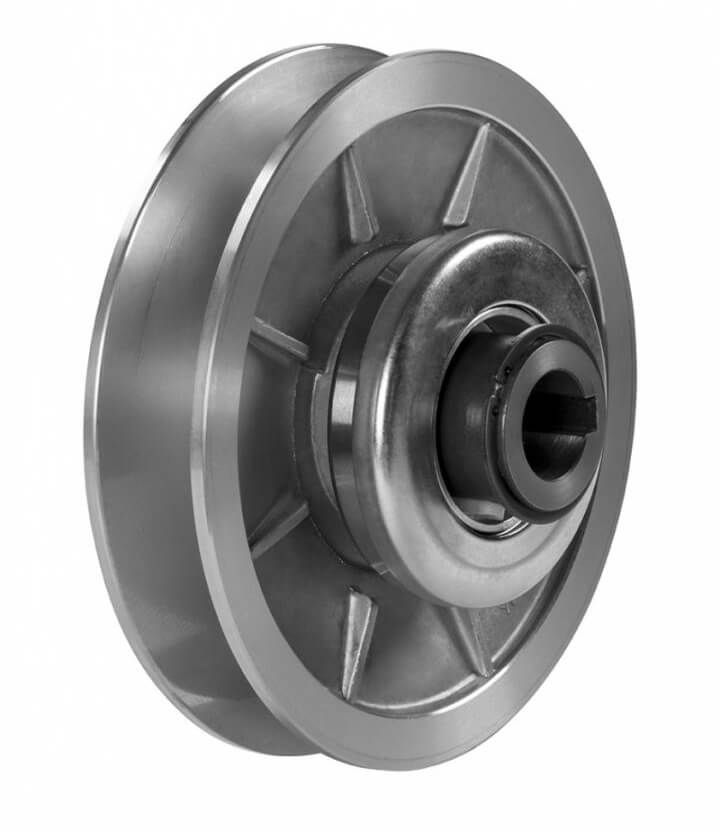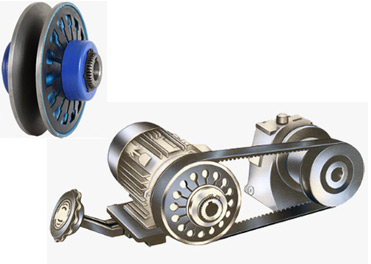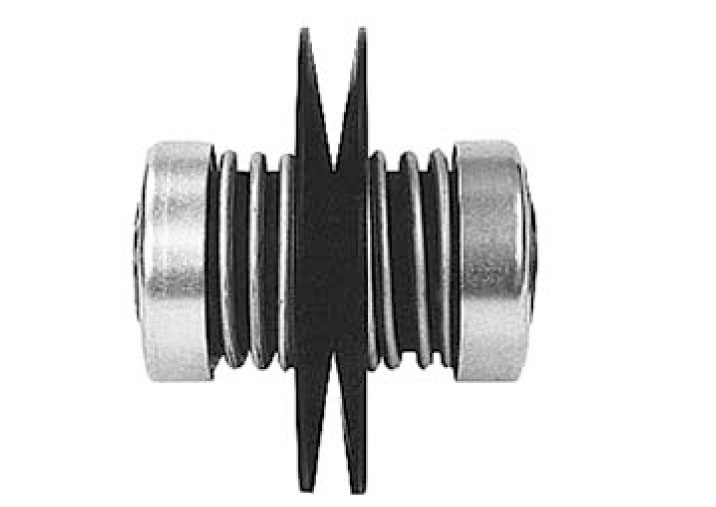Product Description
Cast Iron Split Pulley By Chinese Factory
V-belt Pulleys are found in drive designs in the agriculture, textile, printing, mining, and office equipment industries.
Size Range from 1TB34 TO 1TB380,2TB34 TO 2TB380,3TB34 TO 3TB380
1)Widely used in the North America with good hardness and strength
2)Suitable for 3L/4L/5L or A/B belt or cross section
3)Material: Cast iron
4)Finish: Gray Powder Paint
5)MOQ: 50 pieces
6)Style: One groove
7)Sizes: Outside Diameter 6.95 inches
8)ISO9001:2008 certified
9)CNC machining
10)Strict QC system
11)OEM available
12)Reasonable price
13)On time delivery
14)Clear marking
15)Strong Crate package
Our V-belt Pulley includes
Light Duty Bored To Size Pulleys(AK,BK,2AK,2BK,3BK series)
Light Duty Taper Bore Pulleys(AK-H,BK-H,2AK-H,2BK-H series)
Split taper bushed Pulleys(1TB,2TB,3TB series)
Heavy Duty QD Pulleys(1B,2B,3B series)
Light Duty Variable Speed Pulleys(1VP,2VP,1VL,1VM series)
Single Groove Pulleys(OK,OL,AL series)
Made To Order Designs
Our Inspection Equipment:
Direct-reading spectrograph,metallographic microscope,hardness tester,brinell hardness tester,thermometric indicator,universal testing machine,carbon and silicon analysis meter,magnetic powder flaw detector,digital ultrasonic flaw detector etc.
Our Service:
1.Your inquiry related to our products or prices will be replied in 12 hours.
2.Individual formula according to customers’ special drawing requests.
3.Manufacturer with large capacity,ensures the fast production cycle after
confirming the order.
4.Protection of sales area and private information for all of our customers.
Quality Control:
We have a full set of quality control system to guarantee best product quality. Depending on the products, we can make different Item Testing Plan, Manufacturing procedure etc.
Raw material control
Chemistry spectrum analysis
Mechanical property
Metallographic analysis
Ultrasonic testing
Magnetic testing
Radiographic testing
Dimension inspection
Visual inspection
Penetrant testing
Leak testing
Hardness test
Micro-structure tester after heat treatment
Machining Ability
Our machining shop located in HangZhou using the latest CNC equipment to provide our customer with high quality products.
Horizontal and Vertical Machining Center
CNC lathe and normal lathe
CNC drilling and milling Center
Other assistant equipment
| material | grey cast iron, ductile cast iron, steel, stainless steel, brass, copper, bronze, aluminum, zinc etc |
| process | sand casting, precision casting ,die casting |
| Surface finishment | polishing, sand blasting, heat treatment, painting, powder coating, anodizing, electroplating, mirror polishing. |
| certificate | ISO9001 |
| Service | OEM service available |
| Main export market | Eastern Europe Western Europe North America Mid Africa Central America Asia |
| Type: | Clay Wet Sand |
|---|---|
| Casting Method: | Thermal Gravity Casting |
| Sand Core Type: | Resin Sand Core |
| Application: | Machinery Parts |
| Machining: | CNC Machining |
| Material: | Iron |
| Customization: |
Available
| Customized Request |
|---|

How do variable pulleys enhance the efficiency and precision of machinery and equipment?
Variable pulleys, also known as variable speed pulleys or V-belt pulleys, play a significant role in enhancing the efficiency and precision of machinery and equipment. They provide several benefits that contribute to improved performance and versatility. Here are some ways in which variable pulleys enhance efficiency and precision:
- Speed control: One of the primary advantages of variable pulleys is their ability to control the speed of machinery and equipment. By adjusting the position of the pulley’s movable flanges, the effective diameter of the pulley changes, altering the speed ratio between the input and output shafts. This flexibility allows operators to match the speed of the machinery to the specific requirements of the task at hand, optimizing efficiency and precision.
- Power transmission: Variable pulleys efficiently transmit power from the input shaft to the output shaft through the use of V-belts. V-belts provide a reliable and flexible method of transferring rotational force, allowing for smooth power transmission without slippage. This efficient power transmission minimizes energy losses and ensures that the machinery operates at its optimum power efficiency.
- Load adaptation: Variable pulleys enable machinery and equipment to adapt to different load conditions. By adjusting the pulley’s effective diameter, operators can vary the torque and speed output of the system to match the requirements of the load. This adaptability is particularly useful in applications where the load may vary or where precise control over speed and torque is necessary for achieving desired results.
- Responsive adjustments: Variable pulleys offer quick and responsive adjustments to changes in load or operating conditions. Operators can easily modify the pulley’s position or setting to accommodate variations in workload or to maintain precise speed control. This responsiveness allows for efficient operation and reduces the need for frequent manual adjustments or the use of additional mechanical components.
- Versatility: The use of variable pulleys enhances the versatility of machinery and equipment. By varying the speed and torque output, different types of tasks and operations can be performed using the same equipment. This versatility eliminates the need for specialized machinery for each specific application, leading to cost savings and increased operational flexibility.
- Noise and vibration reduction: Variable pulleys can contribute to the reduction of noise and vibration in machinery. By adjusting the speed and torque output to match the load requirements, excessive strain and stress on the system can be minimized. This reduction in strain helps to decrease noise levels and vibrations, leading to a quieter and more comfortable working environment.

What role do variable pulleys play in achieving variable speed control in machinery?
Variable pulleys, also known as variable speed pulleys or variable drive pulleys, play a crucial role in achieving variable speed control in machinery. They provide a means to adjust the speed ratio between the input and output shafts, allowing for precise control of rotational speed. Here’s how variable pulleys enable variable speed control:
1. Speed Adjustment:
Variable pulleys consist of two pulley halves: a fixed pulley half and a movable pulley half. The movable pulley half can be adjusted along the axis of the shaft, changing its effective diameter. By altering the position of the movable pulley half, the speed ratio between the input and output shafts can be modified. When the movable pulley half is positioned closer to the fixed pulley half, the effective diameter increases, resulting in a higher speed ratio. Conversely, when the movable pulley half is positioned farther away, the effective diameter decreases, leading to a lower speed ratio. This adjustability allows for fine-tuning of the speed control in machinery.
2. Continuous Speed Variation:
Unlike fixed-speed pulleys or gear systems with discrete speed settings, variable pulleys offer continuous speed variation. The adjustment mechanism associated with variable pulleys enables smooth and seamless transitions between different speed ratios. By precisely positioning the movable pulley half, the desired speed can be achieved without the need for manual gear changes or transmission adjustments. This continuous speed variation capability allows machinery to operate at optimal speeds for different tasks or operating conditions.
3. Energy Efficiency:
Variable pulleys contribute to energy efficiency in machinery. By providing adjustable speed control, they allow the system to operate at the most efficient speed for a given task. This optimization minimizes energy waste and reduces unnecessary power consumption. For example, in applications such as HVAC systems or industrial machinery, variable pulleys enable the motor or engine to operate at the most efficient speed, resulting in improved energy efficiency and reduced operating costs.
4. Load Adaptation:
Variable pulleys facilitate load adaptation in machinery. By adjusting the speed ratio, the torque and power characteristics of the system can be optimized to match the specific load requirements. When higher torque is needed, the variable pulley can be adjusted to provide a lower speed ratio, allowing the system to handle heavier loads. Conversely, when speed is a priority, the variable pulley can be adjusted to provide a higher speed ratio, sacrificing some torque in favor of increased rotational speed. This load adaptation capability allows machinery to effectively handle varying load conditions.
5. Control Precision:
Variable pulleys offer precise speed control, enabling machinery to meet specific speed requirements with high precision. The fine adjustments in the effective diameter allow for accurate and controlled speed setting. This level of control precision is particularly advantageous in applications where precise speed synchronization, timing, or regulation is critical, such as in robotics, conveyor systems, or automated manufacturing processes.
By providing adjustable speed control, continuous speed variation, energy efficiency, load adaptation, and control precision, variable pulleys play a vital role in achieving variable speed control in machinery. Their flexibility and ability to fine-tune speed ratios contribute to improved performance, productivity, and efficiency in various industrial and mechanical applications.

What are the advantages of using variable pulleys in various systems?
Variable pulleys, also known as variable speed pulleys or variable drive pulleys, offer several advantages when incorporated into various mechanical systems. Here are some key advantages of using variable pulleys:
1. Adjustable Speed Ratios:
One of the primary advantages of variable pulleys is their ability to provide adjustable speed ratios. By changing the position of the movable pulley half, the effective diameter of the pulley system can be altered, resulting in different speed ratios between the input and output shafts. This feature allows for precise and continuous speed adjustment without the need for manual gear changes or transmission adjustments. It enables systems to operate at optimal speeds for different conditions and tasks, enhancing efficiency and performance.
2. Smooth and Seamless Transitions:
Variable pulleys facilitate smooth and seamless transitions between different speed ratios. The actuation mechanism associated with the variable pulley allows for controlled movement of the movable pulley half, ensuring gradual adjustments in the effective diameter. This results in smooth speed changes without sudden jolts or disturbances in power transmission, contributing to overall system reliability and user comfort.
3. Energy Efficiency:
By providing adjustable speed control, variable pulleys contribute to energy efficiency in various systems. They allow the system to operate at the optimal speed for a given task, minimizing energy waste and reducing unnecessary power consumption. For example, in automotive applications, variable pulleys in continuously variable transmissions (CVTs) enable the engine to operate at its most efficient speed, resulting in improved fuel economy and reduced emissions.
4. Flexibility and Adaptability:
Variable pulleys offer flexibility and adaptability in mechanical systems. They can accommodate different load conditions, operational requirements, and variations in input power. By adjusting the position of the movable pulley half, the speed and power transmission characteristics can be tailored to suit specific needs, allowing for optimized performance in diverse applications.
5. Cost-Effective Solution:
Variable pulleys can provide a cost-effective solution compared to other speed control mechanisms. Their simplicity in design and operation often results in lower manufacturing, installation, and maintenance costs. Additionally, the ability to adjust speed ratios without requiring complex gear systems or transmission components can reduce overall system complexity and associated costs.
6. Precise Speed Control:
Variable pulleys offer precise speed control in mechanical systems. The fine adjustments in the effective diameter allow for accurate speed setting, enabling systems to meet specific speed requirements with high precision. This is particularly advantageous in applications where precise speed synchronization, timing, or regulation is critical.
7. Reduced Mechanical Stress:
The ability to adjust speed ratios using variable pulleys can help reduce mechanical stress on system components. By optimizing the speed and torque characteristics, variable pulleys can minimize undue strain on belts, bearings, gears, and other transmission elements. This can result in extended component life, reduced maintenance, and improved overall system reliability.
These advantages make variable pulleys a valuable component in various systems, including automotive transmissions, manufacturing machinery, HVAC systems, exercise equipment, and power transmission systems. Their ability to provide adjustable speed ratios, smooth transitions, energy efficiency, and precise control contributes to enhanced performance, flexibility, and cost-effectiveness.


editor by CX
2023-12-12
